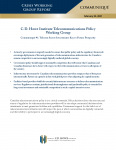 Investment in the telecommunications sector is vital for ensuring Canada’s next generation digital infrastructure. Reliable and leading-edge infrastructure has been seen as essential, thanks to a pandemic-driven shift to remote work and digital services. These are just two of the conclusions drawn from a new report [pdf, 331KB] released last week by the Telecommunications Working Group of the C.D. Howe Institute.
Investment in the telecommunications sector is vital for ensuring Canada’s next generation digital infrastructure. Reliable and leading-edge infrastructure has been seen as essential, thanks to a pandemic-driven shift to remote work and digital services. These are just two of the conclusions drawn from a new report [pdf, 331KB] released last week by the Telecommunications Working Group of the C.D. Howe Institute.
The Telecommunications Working Group identifies policy challenges facing Canada’s telecommunications sector. The group is composed of experts from the private sector and academia. It is co-chaired by Len Waverman, Dean of DeGroote School of Business at McMaster University and Steve Orsini, Adjunct Professor, Public Policy & Administration, Carleton University and President and CEO of the Council of Ontario Universities.
The Telecommunications Policy Working Group was established by C. D. Howe Institute to identify and distill policy directions on strategic questions facing Canadian telecommunications concerning: vigorous competition for competitive pricing and high-quality telecommunications services; investment in next generation infrastructure; and inclusive access to telecommunications services and participation in the digital economy. “Broadly, the Working Group believes governments must focus on regulatory clarity, timeliness, and stability to ensure greater investments in critically needed infrastructure.”
The report leads with 4 key conclusions:
- Action by governments is urgently needed to ensure that public policy and the regulatory framework encourage deployment of the next generation of telecommunications infrastructure for Canada to remain competitive in an increasingly digitally mediated global economy.
- Government policy should support sustainable competition that will ensure that Canadians and Canadian businesses have choice with respect to their telecommunication services in all regions of the country.
- Infrastructure investment by Canadian telecommunications providers outpaces that of their peers internationally. Return on capital is in line with global peers when adjusting for capital intensity.
- Facilities-based providers build the essential infrastructure necessary to deliver telecommunications services. Regulatory certainty, jurisdictional disentanglement and predictable policy is essential for long-term investments and sustainable competition in such a capital-intensive sector.
The report highlights the need for telecom sector investment as a key takeaway: “The current cross-roads for Canada’s telecommunications sector and the economic imperative for expedient deployment of next generation digital infrastructure requires decisive government action to resolve pressing policy challenges. In particular, the federal government must provide facilities-based providers will a clear and predictable regulatory framework that coherently balances vigorous price competition with incentives for ongoing investment to improve network and service quality.”
The communiqué highlights CRTC data that shows the lopsided nature of investment by industry participants. “Resellers make comparably negligible aggregate investments in telecommunications infrastructure: for example, resellers invested $50 million in capital expenditures in 2018, compared with $5.7 billion spent by incumbents and $3.9 billion spent by facilities-based providers.” Fifty million is just 0.5% of the total investment. No wonder some executives in the reseller community have trouble understanding the need for higher EBITDA margins to support the higher levels of investment by Canada’s facilities-based industry participants. Substantial EBITDA margins are needed for businesses with substantial levels of investment.
Analysis by Boston Consulting Group’s Centre for Canada’s Future found that, over the 2005-to-2015 period, Canadian telecommunications infrastructure investment was US$255 per capita compared to an average of US$156 across the OECD, with Canadian per capita investment exceeding all other members of the G7. BCG also observes that, while Canadian telecommunications providers achieve higher earned margins relative to revenue, return on capital is in line with global peers when adjusting for their greater capital intensity. Specifically, while Canadian providers generated higher EBITDA/revenue than those in other OECD countries over 2016-18, their return on capital invested (ROCE) was equivalent with their peers.
According to the report, future communiqués from the Telecommunications Working Group will address specific policy recommendations regarding rate-setting for mandated access and for MVNOs, the framework and timeliness for allocating spectrum, and how to streamline federal and provincial programs and clarify jurisdiction.
In the early days of the COVID-19 pandemic, I wrote about a few of the reports related to telecommunications that emerged from the C. D. Howe Institute:
- Could Political Interference Create ‘Sovereign Risk’ For Canada’s Digital Infrastructure? [March 19, 2020]
- Developing Good Public Policy For Telecom [March 30, 2020]
- A Playbook For Restarting Canada’s Economy [April 20, 2020]
We’ll be watching for further communiqués as they are released.
